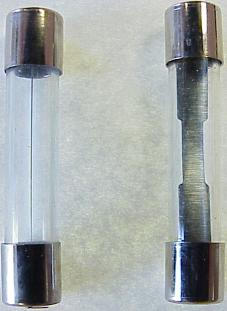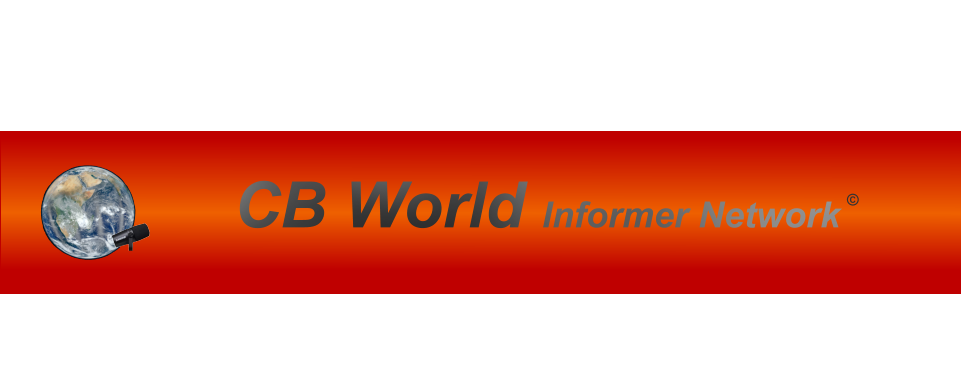CAUTION: Don't Burn Out That Radio!
One type of radio failure that is quite common can be prevented quite easily. That is reverse polarity burnout.
Many radios are needlessly burned out each year when reversing the leads while hooking up 12 volts to the
radio. Even a momentary touching of the leads to the power source in reverse polarity with the radio off can
cause failure. CB and 10 Meter radios have protection diodes at the power source input. Many of these
diodes are rated less than they should be. Even with the properly rated fuse, these diodes will permanently
short out protecting the radio from further damage, causing the radio to constantly blow fuses as soon as
power is applied.
Many radios are marked with polarity signs on the back panel by the power connector. It’s always a good idea
to check that the red wire of the power cord is on the same side of the connector as the (+) side of the power
jack. In the old days, there were radios that used the same 3-pin type power cords with the opposite polarity.
In addition, because these are zip cords, when the leads are pulled apart some red is left on the black wire
leaving a red stripe on the black wire. If close attention is not paid, the black wire can be connected to the hot
side of the power source, all that is needed is for the red wire to brush across any metal object in the vehicle
that is grounded for the radio to be damaged.
Some operators and some so-called techs, knowing about this diode, cut it out when they find it shorted.
Sure, this will fix the short circuit, however, if the radio is ever hooked up reverse polarity again kiss it
goodbye! This diode should be replaced. The diodes in the typical Cobra CB are 1 Amp units. I recommend a
3 Amp diode, and some 10 Meter radios are coming through with them now. When I replace the diode, I
replace it with the same type on the circuit board as long as I can add a 3 Amp diode directly across the
power jack. This is double protection is many cases, especially if the connector has filter chokes in line with
the power jack. In the case of reverse polarity, the short circuit occurs before the chokes, preventing them
from being damaged. If these chokes are discolored, even though they still conduct, some windings could be
shorted out. Once the windings are shorted, noise from the power line can come into the radio unimpeded, as
well as RF from the transmitter can exit through the power leads causing RFI in the vehicle. Power line
chokes that show evidence of being slightly burned should be replaced.
Over fusing a radio can and will do greater damage when the radio is wire to the power source wrong. All to
often, operators replace the blown fuse with the first fuse they come across, usually a 20 Amp fuse. If the
diode is blown out, the heavy fuse means that something else may have to give before the fuse blows.
Usually chokes, circuit traces, the protection diode opening, or all of the above. If the radio is still wired
reverse and the diode or a trace to the diode opens, it’s probably time for a new radio. Electronic components
are sensitive to reverse current. The audio amp, PLL, voltage regulators, capacitors, driver transistor, final
transistor, and many more components will be burned out or damaged. Tracking down these burned out parts
may be relatively quick, but it becomes another story locating damaged components when a circuit isn’t acting
right.

So take care hooking your radio to the power source, never use a fuse rated higher than what the factory
recommends, and never, ever cut out the protection diode.
Bob F

© CB World Informer Network 1996 - 2023 Worldwide Rights Reserved

August
2001 Web
Edition


- August 1996
- September 1996
- October 1996
- November 1996
- December 1996
- Review Of Midland 79-290 AM/SSB Mobile
- Cobra/Uniden SSB Chassis Mod UPDATE
- Clarifiers
- President Jackson Unlocked Clarifier Mod.
- Cobra 148 & Uniden GrantXL Clarifier Mod.
- Cobra 142GTL & Uniden Washington Clarifier
- Uniden Grant Unlocked Clarifier Mod.
- Uniden PCI22 PRO SSB Clarifier Mod.
- Review Of The Northstar DX880HL
- Big Bust At The Consumer Electronics Show
- Bob's CB Has Opened
- January 1997
- The New Mongoose Model 450 Review
- Wilson Antenna Tests The Trucker 5000
- A Company With Interference Solutions
- Solving Telephone RF Interference
- Lowpass Filters: What, Where, And How
- Using Highpass Filters For TVI
- How To Conduct A Noise Audit
- Modern Do-It-Yourself Grounding Techniques
- Using Water Pipes For RF Grounding
- Using Water Pipes For RF Grounding
- February 1997
- The New Emperor TS-3010 Review
- Bulkhead Grounding
- Grounding Coaxial Cable Shields
- Using Anti-Oxidants
- Modern Lightning Protection - RF Entry Ports
- Modern Lightning Protection - AC Power Lines
- Modern Lightning Protection - Control Lines
- Modern Lightning Arrestors - Polyphaser VS I.C.E.
- Modern Lightning Arrestors - Alpha Delta VS I.C.E.
- Modern Lightning Arrestors - Cushcraft VS I.C.E.


- July 2001
- Galaxy DX 2547 Reveiw
- Inside The DX 2547
- DX 2547 Channel Mod
- DX 2547 Clarifier Mod
- DX 2547 Photos
- DX 2547 Manual Excerpts
- The Anttron Story
- Anttron 305 Revisited
- New Antrron Products
- Aries A-SWR 460 Digital Meter
- Barjan Buys Wilson Antenna
- Wilson Electronic In Cell Phone Market
- First Web Issue
- Help Get The Word Out
- August 2001
- Sneak Preview: The New Maverick A24
- Maverick A24 Front Panel Controls
- Maverick Conversion
- Inside The Magnum Maverick A24
- Barjan Buys Francis Antenna
- Wilson Antenna, 1 Year After Barjan Buyout
- CBer Busted
- Astaic's MobileMax
- Solarcon I-Max 2000
- False Performance Claims
- CAUTION: Don't Burn Out That Radio
- Magnum's Filtered Power Cord
- Dragon Super Heavy Duty SO-239 Stud
- CBWI...Give Us Your Opinion
- September 2001
- Reveiw Of The RCI 2950DX
- RCI 2950DX Image Rejection Modification
- RCI 2950DX Coversion & Clarifier Mods
- RCI 2950DX Photos
- RCI 2950DX Board Component Layout
- RCI 2950DX Adjustment Layout
- RM-9807: Petition To Remove 155 Mile Limit
- Slip-Seat Radio Box
- RF Limited UTB-1 Adjustable Talkback Board
- A Message From The Editor
- October 2001
- November 2001
- December 2001
- January 2002
- February 2002
- July 2002
- June 2014









































